Scout Sabbath Services
Overview
Rabbis frequently ask: “What should a Scout Sabbath entail? What should be its goals? Is there a special liturgy prepared?”
The National Jewish Committee on Scouting offers the following as advice or guidelines:

Scout Sabbath offers an opportunity for worshippers to honor Scouts and Scouters, as well as to learn more themselves about the value of Scouting as a youth program chartered to a Jewish organization. It gives a rabbi a framework to address Scouts directly, in addition to speaking about Scouting to the congregation.
Some rabbis use regular liturgy and supplement it with special reading. Others devote the entire worship services to Scouting themes, using Scouts and Scouters as readers. There is no “one right way ” to conduct such a service. Most rabbis understand the purpose to be a strengthening of the bonds between the synagogue and the Scouting unit and plan accordingly.
Many councils have Jewish committees on Scouting which are eager to provide assistance. In addition, many units have chaplains and chaplain’s aides. Utilizing these individuals strengthens their commitments to the Scouting unit and to the Jewish organization that uses the Scouting program.
Another feature central to many service is the presentation of religious emblems. Since its inception in 1910, Scouting has been used by synagogues, churches, and many other religious organizations. Approximately 50 percent of all Scouting units today are chartered to religious groups, because religious leaders have long recognized that scouting provides them with exceptional opportunities to draw youth closer to their congregations.
Religious Awards
It was a natural outgrowth of the relationship between Scouting and Jewish organizations that the religious emblems program was originated to give recognition to youth who had demonstrated religious growth. In 1945 the National Jewish Committee on Scouting issued the Ner Tamid emblem for Boy Scouts and Venturers who are Jewish. Today there is also the Aleph emblem for Cub Scouts and the Maccabee emblem for Tiger Cubs who are Jewish.
Since these emblems were designed and implemented by rabbis and not by the Boy Scouts of America, it is appropriate that they be presented during a religious service at a youth’s synagogue. (A sample Ner Tamid presentation is provided below.)
Maccabee
for Tiger Cubs
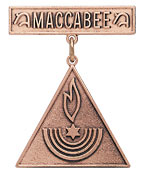 In recent years, as the number of participants in Tiger Cubs has grown, the need has been felt for a comparable challenge on this youngest level. Hence, the creation of the Maccabee Award with its distinct emblem, requirements, and counselor’s guide. The Maccabee Award takes its name from Judah Maccabee and his brothers who led the military and religious struggle against the Syrian king, Antiochus, who attempted to suppress the practice of Judaism. Their revolt ended victoriously in the rededication of the Temple in Jerusalem in the year 168 B.C.E. the holiday of Hanukkah (Feast of Lights) celebrates that victory.
In recent years, as the number of participants in Tiger Cubs has grown, the need has been felt for a comparable challenge on this youngest level. Hence, the creation of the Maccabee Award with its distinct emblem, requirements, and counselor’s guide. The Maccabee Award takes its name from Judah Maccabee and his brothers who led the military and religious struggle against the Syrian king, Antiochus, who attempted to suppress the practice of Judaism. Their revolt ended victoriously in the rededication of the Temple in Jerusalem in the year 168 B.C.E. the holiday of Hanukkah (Feast of Lights) celebrates that victory.
The Maccabee medal is a bronze pendant depicting the Menorah. The pendant is attached to a bronze bar pin that carries the word “Maccabee”.
Aleph
for Cub Scouts
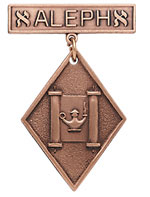 The National Jewish Committee on Scouting has developed the Aleph emblem program to help Jewish boys who are Cub Scouts advance in the knowledge and practice of Jewish religious living. The Aleph program also provides a basis for a positive and close relationship between a Cub Scout and his religious school teacher, who serves as counselor.
The National Jewish Committee on Scouting has developed the Aleph emblem program to help Jewish boys who are Cub Scouts advance in the knowledge and practice of Jewish religious living. The Aleph program also provides a basis for a positive and close relationship between a Cub Scout and his religious school teacher, who serves as counselor.
The Aleph medal is a bronze pendant representing an open Torah scroll and the Eternal Light. The pendant is attached to a bronze bar pin that carries the Hebrew letters “Aleph” and the word “Aleph”.
Ner Tamid
for Scouts and Venturers
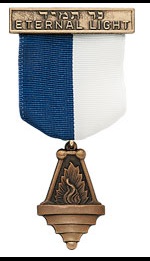 The Ner Tamid emblem is a pendant representing the Eternal Light. It is attached to a blue-and-white ribbon and a bronze bar pin that carries the inscription “Ner Tamid” in Hebrew and “Eternal Light” in English.
The Ner Tamid emblem is a pendant representing the Eternal Light. It is attached to a blue-and-white ribbon and a bronze bar pin that carries the inscription “Ner Tamid” in Hebrew and “Eternal Light” in English.
The Boy Scouts of America has authorized the Ner Tamid emblem to be worn over the left breast pocket at the left of the Eagle Scout badge. When the Eagle badge is not worn, the Ner Tamid is centered above the flap of the left breast pocket.
Sample Ner Tamid Presentation
Given by a Scoutmaster
As I stand on this pulpit this Sabbath evening, in front of the Holy Ark with the Ner Tamid above, facing the Scouts entrusted to my care, I have a deep sense of well-being and achievement as a Scoutmaster.
This well-being and achievement is reflected in the culmination of the striving for the finest in living as taught by the Scout Law, learned in the Scout Oath, and practiced daily for good citizenship by every member of the troop. This sense of achievement and satisfaction is shared by every troop leader, and it is for this reason and for the love of working with youth that others like myself devote their time to youth leadership.
I feel very humble for the opportunity given me to lead in an organization whose purpose is to provide an ethical foundation on which youth may grow.
The responsibility of leadership is more deeply felt when one faces a youth in this sanctuary and realizes how significant the Scout Law and Scouting have become in one’s life, particularly the twelfth point of the Law, which states “A Scout is reverent.” It is this reverence for God and one’s faith that compels a youth to work so diligently to earn the Ner Tamid emblem, which signifies a year of concentrated religious activity.
What symbol could be more truly the symbol of Scouting and reverence toward God than the Ner Tamid, the eternal light? It is this eternal light that serves as a beacon and a flame to the Scoutmaster. In my heart is the desire to serve youth because training our children is our greatest responsibility, and, I might add, hope for the future.
This Scout joins the group of outstanding Scouts who show great promise for the future. He brings great pride to his rabbi, his parents, his Scoutmaster, and troop committee as he stands ready to accept the Ner Tamid emblem – the Eternal Light of Judaism.
It is an honor to work with young men like (names), and it is with deep thankfulness that I address the parents of boys like (names). For without them and their guidance toward activities for their children, the Ner Tamid program and others of high merit would not have come into being.
Parents have an obligation to their children that is not written in any books, but lies deep in their hearts. It is this heartfelt determination to help make their children the best they can be that has brought about Scouting.
It is a great honor and privilege for me to witness the presentation of the Ner Tamid emblem to (name). I hope that he will always be as alert and watchful as the Ner Tamid and ever be the living example of the teachings of Judaism through Scouting.
Etz Chaim
for older Scouts and Venturers
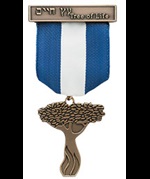 The Etz Chaim (Tree of Life) Award is designed for Boy Scouts in high school, ages 14 to 18, and registered Venturers ages 14 to 20. The purpose of the award is to encourage the young adult to explore adult Jewish roles in the context of family, community, and Jewish people. The requirements can be completed in six months and with a counselor’s assistance.
The Etz Chaim (Tree of Life) Award is designed for Boy Scouts in high school, ages 14 to 18, and registered Venturers ages 14 to 20. The purpose of the award is to encourage the young adult to explore adult Jewish roles in the context of family, community, and Jewish people. The requirements can be completed in six months and with a counselor’s assistance.
Shofar
for adult volunteers
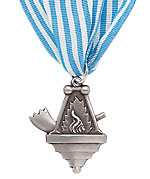 The National Jewish Committee on Scouting has established the Shofar Award, which is a silver Ner Tamid pendant superimposed on a silver Shofar, suspended from a blue-and-white ribbon. The award was developed to recognize outstanding service by adults in the promotion of Scouting among Jewish boys.
The National Jewish Committee on Scouting has established the Shofar Award, which is a silver Ner Tamid pendant superimposed on a silver Shofar, suspended from a blue-and-white ribbon. The award was developed to recognize outstanding service by adults in the promotion of Scouting among Jewish boys.

